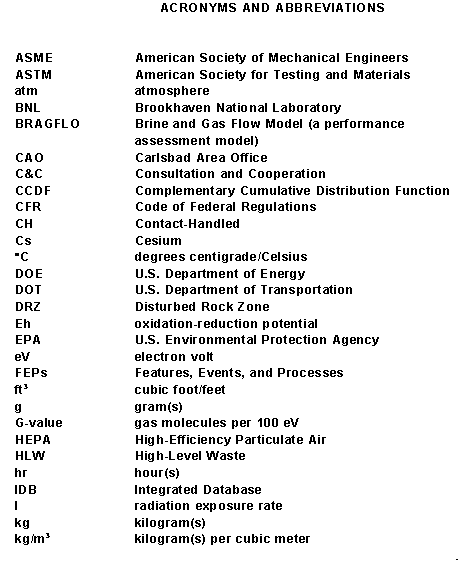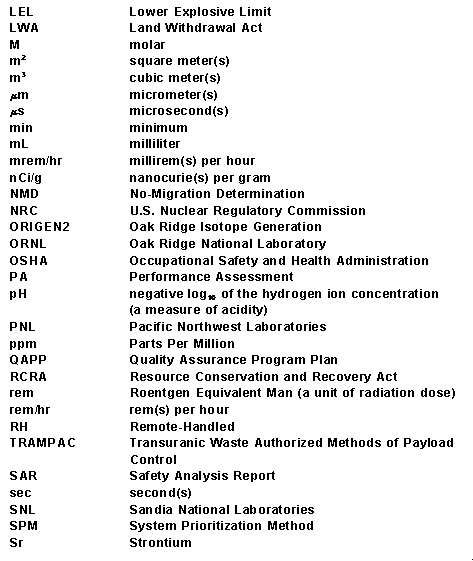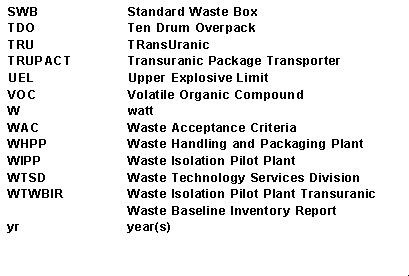WIPP Remote-Handled Transuranic Waste Study
Main Menu
DOE/CAO 95-1095 REMOTE-HANDLED TRANSURANIC WASTE STUDY

U.S. Department of Energy
Carlsbad Area Office
Carlsbad, New Mexico
October 1995
This document has been reproduced directly from the best possible copy. It is available to DOE and DOE contractors at the following address:
Office of Scientific and Technical Information
P.O. Box 62
Oak Ridge, TN 37831
For prices contact (615) 576-8401
The local WIPP contact for this document is George Basabilvazo (pronounced Baasa-bill-vaaso) (505) 234-7488 or E-Mail George.Basabilvazo@wipp.ws
TABLE OF CONTENTS
ACRONYMS AND ABBREVIATIONS (See below)
EXECUTIVE SUMMARY (See below)
1.0 INTRODUCTION
1.1 Objectives
1.2 Background
2.0 THE TRANSURANIC WASTE DISPOSAL STRATEGY
2.1 Room Configuration
2.2 Waste Packaging
2.3 TRU Waste Inventory
3.0 COMPARISON OF CONTACT-HANDLED AND REMOTE-HANDLED TRANSURANIC WASTES
3.1 "As-Received" Inventory Description and Comparison
3.1.1 TRU Waste Inventory
3.1.2 TRU Radionuclide Inventory
3.2 Comparison of LWA Issues During the Post-Closure Period
3.2.1 Gas Generation
3.2.2 Flammability and Explosiveness
3.2.3 Solubility
3.2.4 Brine and Geochemical Interactions
3.3 Conclusions
4.0 ANALYSIS OF THE IMPACT OF REMOTE-HANDLED WASTE ON PERFORMANCE ASSESSMENT
4.1 Gas Generation
4.2 Radionuclide Migration by Groundwater Transport
4.3 Cuttings Releases by Human Intrusion
4.4 Radiolytic Heat Generation
4.5 Conclusions
APPENDICES
APPENDIX A -- RH-TRU SHIELD PLUG AND CANISTER DESCRIPTION
APPENDIX B -- DISPOSAL RADIONUCLIDE INVENTORY
APPENDIX C -- ORIGEN MODEL RESULTS FOR RADIONUCLIDE ACTIVITY, 0 10,000 YEARS, AND RADIONUCLIDE DECAY SERIES
APPENDIX D -- GAS GENERATION MECHANISMS
APPENDIX E -- ANALYSIS SUPPORTING EVALUATION OF BRINE AND GEOCHEMICAL INTERACTIONS
ACRONYMS



EXECUTIVE SUMMARY
The Waste Isolation Pilot Plant (WIPP) was developed by the U.S. Department of Energy (DOE) as a research and development facility to demonstrate the safe disposal of transuranic (TRU) radioactive wastes generated from the Nation's defense activities. One of the primary goals of the DOE waste program is to terminate interim storage [Public Law 96-164, 1979] and to achieve permanent disposal of DOE TRU defense wastes. The WIPP disposal inventory will consist of 6.2 million cubic feet (~176,000 cubic meter(s)) of TRU wastes, which includes up to 250,000 cubic feet (7,080 cubic meter(s)) of TRU wastes classified as remote handled (RH). The remaining inventory will include contact-handled (CH) TRU wastes, which characteristically have less specific activity (radioactivity per unit volume) than the RH-TRU wastes.
Disposal of RH-TRU waste will have a minimal impact on the long-term performance of the WIPP repository. The WIPP Land Withdrawal Act (LWA), Public Law 102-579, requires a study of the effect of RH-TRU waste on long-term performance. However, the most significant concern with RH-TRU waste is relative to the operational aspects for handling this type of waste, which has been addressed in previous studies. Because of the penetrating radiation associated with RH-TRU wastes, special equipment and facilities are required for disposal operations. The WIPP has existing equipment and facilities designed for handling these wastes in a safe and efficient manner.
This RH-TRU Waste Study has been conducted to satisfy the requirements defined by the LWA and is considered by the DOE to be a prudent exercise in the compliance certification process of the WIPP repository. The specific project requirements for the RH-TRU waste study are addressed in Section 6(c)(2)(B) of the LWA [Public Law 102-579, 1992] under WIPP test phase activities limitations. The LWA includes several restrictions on actual waste experiments once planned at WIPP during the test phase, including prohibiting the use of RH-TRU wastes. In lieu of conducting experiments with RH-TRU wastes, the LWA includes requirements for DOE to conduct a study to evaluate the impacts of RH-TRU wastes on the repository. The objectives of this study include:
Conducting an evaluation of the impacts of RH-TRU wastes on the performance assessment (PA) of the repository to determine the effects of RH-TRU waste as a part of the total WIPP disposal inventory; and
Conducting a comparison of CH-TRU and RH-TRU wastes to assess the differences and similarities for such issues as gas generation, flammability and explosiveness, solubility, and brine and geochemical interactions.
This study was conducted using the data, models, computer codes, and information generated in support of long-term compliance programs, including the WIPP PA. The study is limited in scope to post-closure repository performance and includes an analysis of the issues associated with RH-TRU wastes subsequent to emplacement of these wastes at WIPP in consideration of the current baseline design. Operational and transportation elements of the RH-TRU waste program are not assessed in this document.
The RH-TRU waste inventory to be disposed in WIPP has primarily the same physical characteristics as those of CH-TRU wastes. These characteristics are identified as those parameters that have the potential to impact repository performance under anticipated repository conditions. The important waste material parameters (as defined by performance assessment) for CH-TRU and RH-TRU wastes are the basis for the Waste Isolation Pilot Plant Transuranic Waste Baseline Inventory Report (WTWBIR), which includes a survey of the quantity of each waste material parameter (e.g., metals, cellulosics, and plastics), as well as the radionuclide content. The WTWBIR provides the waste inventory definition used in this RH-TRU waste study as well as performance assessment modeling.
CH-TRU and RH-TRU wastes contain the same radioactive materials (radionuclides). The two types of wastes are differentiated by the relative quantities of these radionuclides. The distinguishing difference between CH-TRU and RH-TRU wastes is the specific radioactivity of relatively short-lived beta and gamma emitters, including the fission and activation products that are characteristic of RH-TRU wastes. Although the CH-TRU inventory includes a minor amount of short-lived radionuclides relative to the RH-TRU inventory, the predominant radioactivity is from long-lived alpha emitters that exhibit minimal beta and gamma emissions and have a lower specific radioactivity. Because gamma radiation is more penetrating than alpha radiation, gamma emitters require additional shielding while being handled beyond that required for CH-TRU waste. The relatively rapid decay of RH-TRU beta and gamma radionuclides with half-lives of 30 years or less results in low (<10 Ci/cubic meter(s)) radioactivities within about 200 years. After this period, the CH-TRU and RH-TRU waste forms will consist of similar radionuclide inventories and therefore can reasonably be assumed to impact the repository by a degree proportional to the additional mass of the RH-TRU inventory.
As this study demonstrates, the inclusion of approximately 5 percent by volume of RH-TRU waste in the disposal inventory is essentially indistinguishable from an inventory that is limited to only contact-handled waste in the analytical assessment of long-term performance of the repository. This study concludes that CH-TRU and RH-TRU wastes are very similar with respect to the expected contribution of gas generation, flammability and explosiveness, solubility, and brine and geochemical interactions within the disposal system. The evaluation of the impact of RH-TRU on PA concluded that its effect on the repository performance will be negligible over the 10,000-year regulatory period. This is because RH-TRU is limited to only 5 percent of the waste volume, the waste materials are very similar, and radionuclides in the RH inventory will decay to activities less than that in the CH inventory within about 200 years.
Notice To Users: Use of this system constitutes consent to security monitoring and testing. All activity is logged
with your host name and IP address. For more information, please refer to the DOE Privacy Policy
Please report problems to: webmaster@wipp.ws